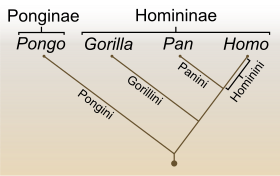Homininae
| Homininae | ||||||||||||
|---|---|---|---|---|---|---|---|---|---|---|---|---|

A human with a young gorilla and a young chimpanzee |
||||||||||||
| Temporal occurrence | ||||||||||||
| Middle Miocene to present time (recent) | ||||||||||||
| 11 to 0 million years | ||||||||||||
| Locations | ||||||||||||
|
||||||||||||
| Systematics | ||||||||||||
|
||||||||||||
| Scientific name | ||||||||||||
| Homininae | ||||||||||||
| Gray , 1758 | ||||||||||||
| Tribe | ||||||||||||

As Homininae a is subfamily (a hierarchical level of the taxonomic system) of the apes designated (Hominidae) in which the gorillas , the chimpanzees and humans , including all its ancestors to the separation of the development line of orangutans are summarized.
Systematics
For terminological confusion, provides that in the recent literature alone hominin to humans and their ancestors to the junction of chimpanzees is (that is, for the Hominini ), however, often in the older literature hominid within the meaning of hominin is used. This is done against the background that the taxonomists to the 1980s, the taxonomy of Linnaeus followed that only orangutans , gorillas and chimpanzees in the family of great apes ( Pongidae combined) and this family of Real People (Hominids; eingedeutscht: Hominids) - with Homo sapiens as the only living species. However, based on genetic comparisons, it was later shown that chimpanzees and gorillas are more closely related to humans than to orangutans. Therefore humans, chimpanzees and gorillas together with all their fossil ancestors were combined into a common taxon (the homininae) and this was placed next to the taxon of the orangutans ( ponginae ).
See also
literature
- Henry Gee : Hominid and hominin. In: Nature . Volume 412, 2001, p. 131.
- Winfried Henke , Hartmut Rothe : Tribal history of humans: An introduction. Springer, Berlin 1998, ISBN 978-3540648314 ; Full text (see in particular pp. 45 - 47).
Web links
Individual evidence
- ^ David R. Begun : Dryopithecins, de Bonis, and the European origin of the African apes and human clade. In: Geodiversitas. Volume 31, No. 4, 2009, pp. 789–816, full text (PDF; 3.0 MB)
- ↑ Gerhard Heberer had, among other things, in Anthropologie - Das Fischer Lexikon (Fischer Taschenbuch-Verlag, Frankfurt, 1970, p. 39 ff.) Compared the australopithecines as the “most structurally primitive human hominids” with the “higher hominids” and referred to them as “homininae ". "To emphasize the 'genuinely' human, one can use the prefix 'Eu': (Eu) Homininae." This resulted in the Germanization of "real people", which was later occasionally used as a paraphrase for the hominini, but today in scientific discourse is only related to the genus Homo .
- ↑ Goodman et al .: Toward a phylogenetic classification of primates based on DNA evidence complimented by fossil evidence. In: Molecular Phylogenetics and Evolution. Volume 9, 1998, pp. 585-598, doi : 10.1006 / mpev.1998.0495 .
- ↑ David R. Begun: The Age of the Great Apes . In: Spectrum of Science . Dossier 01/2004: Human evolution II. P. 8.
- ↑ Pasqual Pic: The evolution of man. In: Spectrum of Science. Dossier 01/2004: Human evolution II. P. 17.